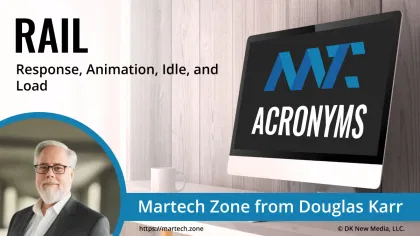RAIL
RAIL is the Acronym for Response, Animation, Idle, and Load

A performance model introduced by Google to help developers deliver smooth, fast, and user-centered web experiences. The acronym stands for four key user experience (UX) aspects that guide developers in optimizing web performance. Unlike older metrics focused purely on load time, RAIL is grounded in user expectations and interaction timing, making it a more practical and actionable model for modern web design.
Response: Respond to User Input within 100 milliseconds
Users expect immediate feedback when they interact with a website—whether tapping a button, clicking a link, or entering text. If the UI doesn’t acknowledge an action within 100ms, users perceive the interface as laggy or broken. To keep interactions responsive, RAIL recommends breaking long tasks into smaller, asynchronous chunks and deferring non-essential logic.
Animation: Produce frames consistently at 60 frames per second
Smooth animations—including scrolling, transitions, and interactive movements—should run at 60 fps, which gives a 16ms budget per frame (including rendering and paint time). Dropped frames or jank disrupt the user experience. Techniques like GPU acceleration, avoiding layout thrashing, and minimizing DOM manipulation help maintain a consistent frame rate.
Idle: Maximize Idle Time Without Blocking the Main Thread
Idle time is when the app is not actively responding to input or animating. RAIL encourages developers to use idle time (ideally chunks of 50ms or less) to prefetch resources, warm up components, or prepare for anticipated user actions, without interrupting responsiveness. Proper use of requestIdleCallback or task scheduling can improve performance during these lulls.
Load: Deliver Meaningful Content In Under 1 Second
While full-page load may take longer, users should see primary content and be able to begin interacting with the page in under one second, especially on mobile networks. Strategies to achieve this include reducing critical render path length, compressing assets, lazy-loading non-essential elements, and prioritizing visible content.
Why RAIL Matters
RAIL shifts the focus from raw load speed to user perception and interaction quality. By aligning performance metrics with what users notice and care about—like tap delay, janky animations, or slow initial render—developers can create experiences that feel faster and more intuitive, even if total load times remain unchanged.
RAIL has also informed Google’s evolving Core Web Vitals (CWV) initiative, which includes metrics like Largest Contentful Paint (LCP), First Input Delay (FID), and Cumulative Layout Shift (CLS), all rooted in the same user-centric principles.
In short, RAIL helps teams prioritize what matters most: how users feel when they use your site. It bridges the gap between technical metrics and human experience, providing a clear framework for performance optimization decisions.



